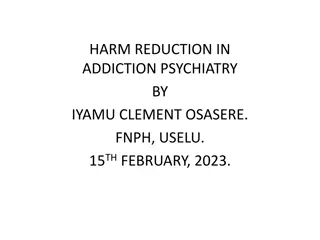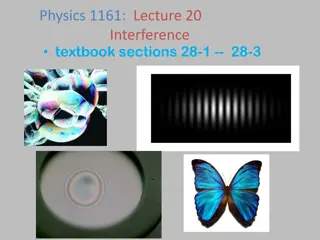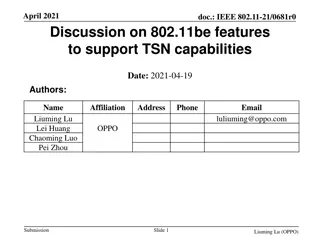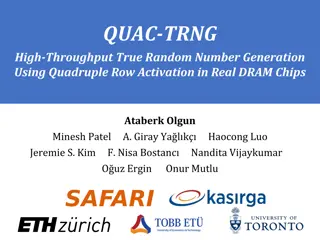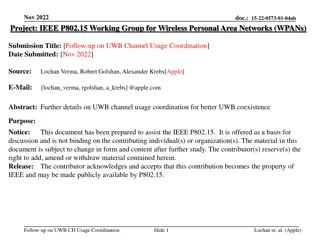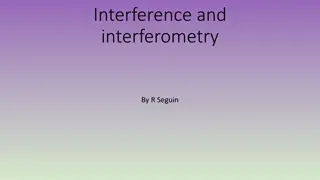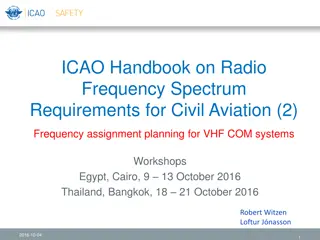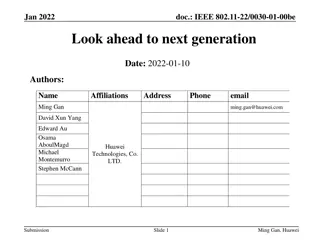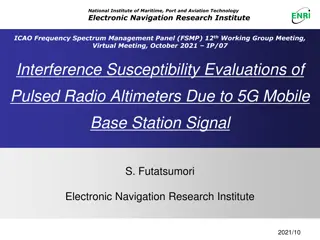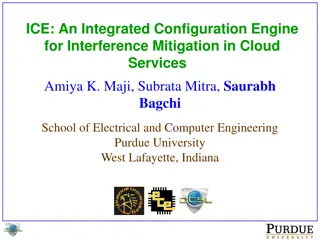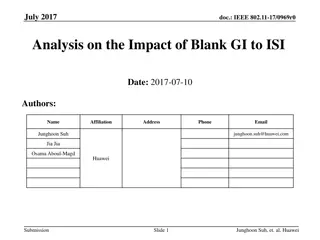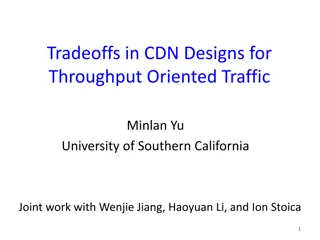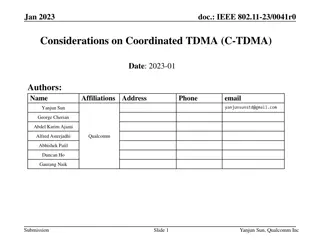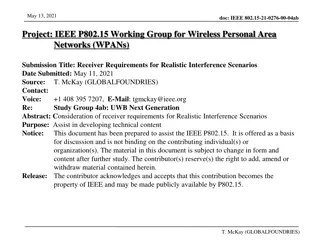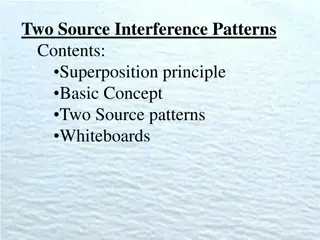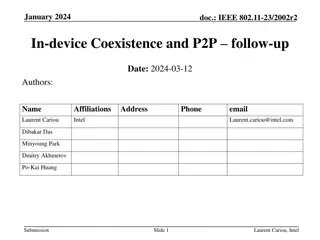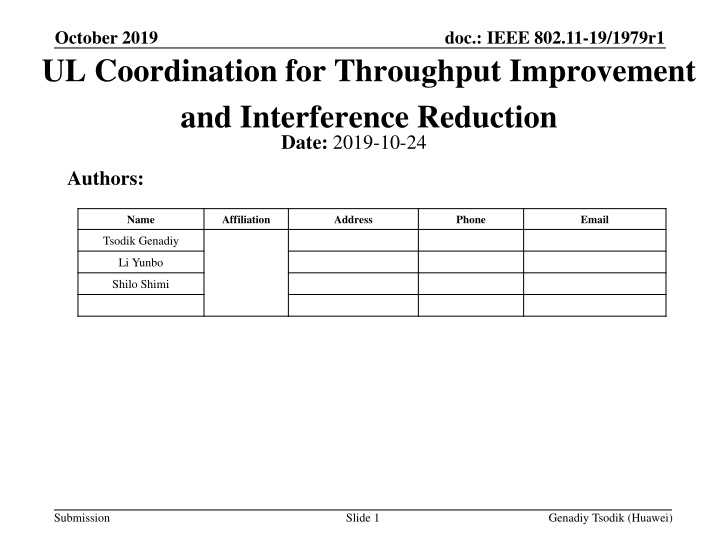
UL Coordination for Throughput Improvement and Interference Reduction in Wi-Fi Networks
Discover how UL coordination in Wi-Fi networks can enhance throughput and minimize interference through parallel transmissions of multiple UL packets. Explore solutions addressing AP coordination, spectral efficiency, and advanced decoding schemes for better spatial efficiency.
Download Presentation

Please find below an Image/Link to download the presentation.
The content on the website is provided AS IS for your information and personal use only. It may not be sold, licensed, or shared on other websites without obtaining consent from the author. If you encounter any issues during the download, it is possible that the publisher has removed the file from their server.
You are allowed to download the files provided on this website for personal or commercial use, subject to the condition that they are used lawfully. All files are the property of their respective owners.
The content on the website is provided AS IS for your information and personal use only. It may not be sold, licensed, or shared on other websites without obtaining consent from the author.
E N D
Presentation Transcript
October 2019 UL Coordination for Throughput Improvement and Interference Reduction Date: 2019-10-24 doc.: IEEE 802.11-19/1979r1 Authors: Name Affiliation Address Phone Email Tsodik Genadiy Li Yunbo Shilo Shimi Submission Slide 1 Genadiy Tsodik (Huawei)
October 2019 doc.: IEEE 802.11-19/1979r1 Introduction AP coordination is widely discussed in 802.11be, where the main motivation is to increase DL throughput and coverage by allowing two or more APs to transmit simultaneously This concept is mostly based on advanced Tx BF schemes which can be achieved by aggregating many Tx antennas across several APs Assuming many APs will be equipped with at least 8 Rx antennas, advanced decoding schemes may also be applied at the AP side In this presentation we suggest an UL Coordination scheme that may allow parallel transmissions of multiple UL packets and enable better spatial efficiency of the Wi-Fi network Submission Slide 2 Genadiy Tsodik (Huawei)
October 2019 doc.: IEEE 802.11-19/1979r1 Problem Formulation The simplest scenario is two STAs, associated with different APs, where each AP is equipped with multiple receive antennas AP1 triggers STA1 to transmit an UL frame, and AP2 wants to trigger STA2 to transmit an UL frame Assuming AP1 transmits a trigger frame first, AP2 would refrain from triggering STA2 and wait till STA1 finishes its UL transmission, otherwise mutual interference may prevent both packets from being detected This means that spectrum efficiency is limited h2 STA2 h1 Rx Beam AP2 AP1 STA1 Submission Slide 3 Genadiy Tsodik (Huawei)
October 2019 doc.: IEEE 802.11-19/1979r1 Potential Solutions Spectral efficiency in the scenario we mentioned in the previous slide may be improved if we allow AP2 to transmit/trigger a parallel UL transmission This problem is addressed in 802.11ax by SR techniques, where the main direction is to limit the Tx power of the parallel transmission and ensure small or negligible interference However, we can achieve higher spectral efficiency by applying AP coordination methods for UL transmission and considering advanced Rx decoding schemes The main idea is to reuse the UL MU-MIMO scheme, where each STA will be allocated with different spatial stream indices (columns of the P-matrix) This means that transmitted signals should be aligned in time and frequency, which is a similar requirement to that of DL AP Cooperation currently discussed in 802.11be Data Frame MU-MIMO HE-LTF STA1 Data Frame MU-MIMO HE-LTF STA2 Submission Slide 4 Genadiy Tsodik (Huawei)
October 2019 doc.: IEEE 802.11-19/1979r1 UL AP Coordination Requirements The main concept hence is parallel aligned UL transmission; here we discuss the respective requirements In order to allow the AP to implement efficient MU-MIMO detection or interference mitigation we need to consider at least the following: Time and frequency synchronization: similar to AP coordination in the DL, synchronization has a huge impact on the performance; we assume that synchronization will be maintained for DL coordination in 802.11be, thus no need for additional methods to be implemented Packet duration: Rx BF may be very efficient in presence of interference, however if interference cancelation is applied on a signal with no interference may cause performance degradation; thus we have to align between duration of two frames or at least to indicate to the receiver when to stop applying Rx BF Interference covariance estimation: many Rx BF techniques are based on estimated spatial covariance of the interfering signal, thus we need to allow accurate covariance estimation Submission Slide 5 Genadiy Tsodik (Huawei)
October 2019 doc.: IEEE 802.11-19/1979r1 Detection Options Assuming MU-MIMO format is used, two possible detection schemes can be considered (i.e. not limited only to APs with MIMO detection capabilities): Joint detection similar to regular (UL) MU-MIMO, the AP can decode the received signals jointly and then discard of the irrelevant information h1 h1 LLR1 y MU-MIMO Channel Estimation MIMO Decoder FEC h2 Rx LLR2 h2 Interference mitigation AP may consider the estimated channel of the second signal as an interference and mitigate it applying an Rx beamforming technique (for example, noise covariance whitening) h1 h1 h2 y Data Detector Interference Covariance Estimation MU-MIMO Channel Estimation Cholesky Rx h2 Submission Slide 6 Genadiy Tsodik (Huawei)
October 2019 doc.: IEEE 802.11-19/1979r1 UL Coordination Procedure Diagram Following the last slide we may apply the next procedure for UL coordination Master and Slave AP negotiate such that they are aligned on coordinated UL transmission parameters Master AP may suggest or limit the number of spatial streams to be used by parallel UL transmission, while slave AP may respond with actual number of streams The relevant information is indicated during coordination negotiation procedure: packet duration, allocated RUs, #Nss, MCS (required for joint detection), Tx power limits etc. UL Transmissions are triggered trigger may be transmitted in several formats (jointly, in parallel or serial trigger transmission) Master AP UL Coordination Negotiation Procedure Coordinated UL Trigger Slave AP Full Alignment Data Frame MU-MIMO HE-LTF STA1 Data Frame MU-MIMO HE-LTF STA2 Time Submission Slide 7 Genadiy Tsodik (Huawei)
October 2019 doc.: IEEE 802.11-19/1979r1 Simulation Parameters We compare between four different schemes: UL transmission with no interference Non-Coordinated UL transmission with interference Coordinated UL transmission with interference applying interference cancellation UL transmission with no interference, with reduced number of Rx antennas following the theory that each synchronized interferer requires single antenna to mitigate it Simulation parameters: TGnD channel model, MCS4, LDPC, 1000B SIR in range of 7-17dB MMSE detection 8 or 16 Rx antennas, Nss = 2 Submission Slide 8 Genadiy Tsodik (Huawei)
October 2019 doc.: IEEE 802.11-19/1979r1 Simulation Results In the figures below we can see the results of the simulations We can see that very good performance can be achieved in presence of strong interference if synchronization is assumed, where degradation of ~2-2.5dB is observed for UL coordinated transmission with Nss=2 (compared with the no-interference case!) Submission Slide 9 Genadiy Tsodik (Huawei)
October 2019 doc.: IEEE 802.11-19/1979r1 Conclusions UL coordination may significantly improve efficiency of a Wi-Fi network by allowing simultaneous transmissions Very good performance can be achieved applying existing MU-MIMO transmission format for HE-LTF field AP can independently choose which type of detection to apply based on its own capabilities No need for any payload exchange (information bits at Tx or LLRs at Rx) The proposed method relies on DL AP coordination synchronization techniques (already being considered in 802.11be) and thus requires no additional algorithms Submission Slide 10 Genadiy Tsodik (Huawei)
October 2019 doc.: IEEE 802.11-19/1979r1 Straw Poll Do you think UL AP Coordination is an appealing direction which should be further evaluated in 802.11be? Y/N/A Submission Slide 11 Genadiy Tsodik (Huawei)

